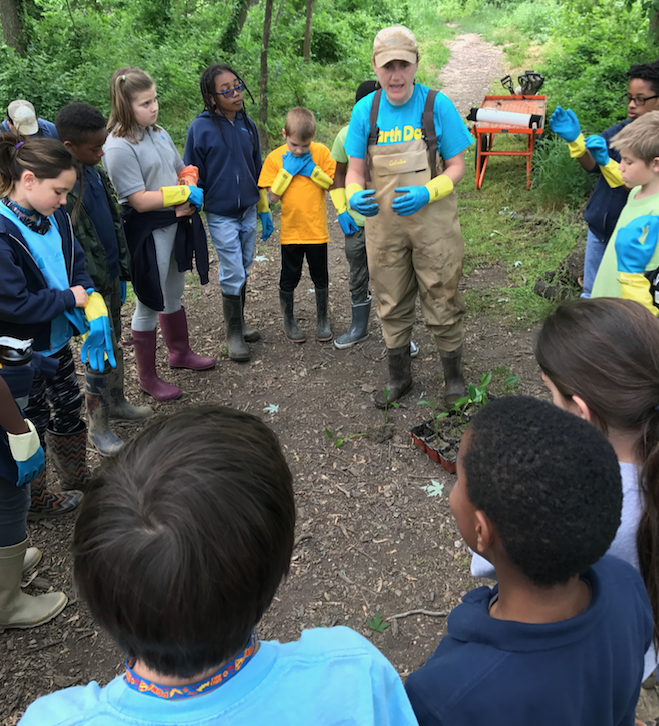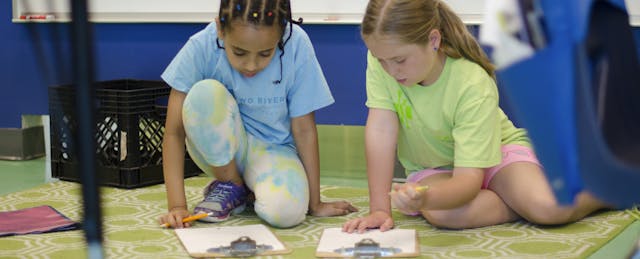Last spring, students at our school, Two Rivers Public Charter School in Washington, DC, were busy creating solutions in response to challenging problems as part of semester long projects that we call expeditions. Students in pre-K busily painted wooden structures that would become Little Free Libraries in a neighborhood near our school. Fourth graders put finishing touches on pamphlets and presentations about how individuals can make a difference in cleaning up our local watershed to share at their River Fair. Sixth graders edited short films to educate the public about the science behind climate change for the District of Columbia Environmental Education Consortium’s 1-Minute Climate Change Filmmaking Project.
As an EL Education school (formerly Expeditionary Learning), we are committed to a broader definition of student success that values not only mastery of skills and knowledge, but also the development of character and collaboration skills, and the production of high-quality work. Our approach to project-based learning provides opportunities to build the skills that students need to work together to collectively solve problems, while simultaneously developing deep content knowledge.
As students work towards a common goal, project-based learning provides opportunities to personalize learning for each individual. In our school, choice is a core element of personalization. By offering students choices at every juncture of a project, we encourage them to take ownership—but there is a common misconception that “choice” means wide, open choice, and that isn’t the case.
At Two Rivers, we set up guardrails so that students have opportunities to make decisions—but these opportunities are thoughtfully crafted by the educators who understand their students’ strengths, areas for growth and interests. Without these guardrails, we aren’t able to ensure deep and lasting outcomes for all students because some students may choose an easier path or focus on content that doesn’t drive them closer to a meaningful solution.
Defining Problems, Pathways, and Solutions
To tailor learning experiences to meet the needs of every student, we have to set up guardrails that define the outcomes and choices students will make within the context of a project. We want students to have meaningful opportunities to make choices throughout the course of each project to meet their own learning needs, while at the same time driving towards collective solutions.
Guardrails define the parameters of a project to ensure that all students accomplish a set of common outcomes. They can relate to the problem that the project will address, the pathways students will take to learn the relevant content and skills, and the solutions students develop to address the problem.
At Two Rivers, we always begin planning expeditions by defining the problem that will sit at the heart of each project. When identifying problems, we have three criteria that are essential: content, student profiles and context. We always start with the content defined by our state standards in science, social studies, and English language arts. Clearly articulating each standard in student friendly language is critical. Then we consider our student profiles including what knowledge, skills and interests each learner will bring to the project. Finally, we look for authentic contexts in which students can utilize the targeted content. For this last problem criterion, we look for partners in the community that have a real need that our students can help solve by applying their content learning.
Once we have articulated the problem, we design pathways for learning—what students will learn and how they will learn it. Acknowledging the differences in interest, background knowledge and skills, we intentionally develop experiences that give all students access to the core content through multiple avenues such as reading a text, interviewing an expert or visiting a space. We also want to ensure that pacing is flexible so that students can take the time they need to master the basic content, and are free to move forward and dive deeper when they’re ready.
The last guardrail relates to building solutions to the problem presented. We think about the decisions that students might make around the medium, design and content that will go into any final output. We consider what aspects we want to leave students to grapple with, and what we want to take off the table for them. Sometimes it is useful to have a medium in mind with which we want students to work. This allows us to guide learning around how to use the media. Other times, students should have the opportunity to choose the media themselves. Similarly, there are often design choices to be made when building a solution. In some cases, that’s where we want students to place their cognitive energy. Other times we set up a guardrail and give direction around design.
Guardrails Vary by Age and Project Type
The three projects highlighted earlier offer a glimpse into how we set up guardrails around problems, pathways and solutions in project-based learning across different grade levels.
Creating Little Free Libraries in Pre-K
Every year, our pre-K classes complete an expedition around building. Students learn the importance of making a plan and following through. Last spring, in connection with one of Washington DC’s Advisory Neighborhood Commissions, our Pre-K teachers identified an authentic problem in our community that the students could help solve by learning about building—some people don’t live close to a library. To solve the problem, students worked together to build something to help people get books in their neighborhood.
The students learned about materials for construction, important design considerations, and how to make a plan and stick to it. For our youngest students many of the pathways for learning content were decided by adults including reading books, building regularly with construction materials, visiting a construction site and talking to experts. However, students did have opportunities to make choices about building materials, building design and text selection at centers.
Working with parent volunteers, students applied their learning by building and decorating little free libraries—small boxes that sit on posts designed for sharing books. The libraries were installed in five front yards in a closeby neighborhood.
Setting up appropriate guardrails for four-year-olds requires acknowledging their developmental needs. Children this young need both structure and flexibility. Without some structure, students wouldn’t have been able to build a strong foundation for their library. And without flexibility, students wouldn’t have had the opportunity to make meaningful design choices—it’s a careful balance.

Fourth Graders Host a River Fair
Last year as part of our annual fourth grade expedition on local ecology, teachers identified the problem of how to harness the power of the community to make the Anacostia River—one of the two rivers in that flows through Washington, DC—a swimmable and fishable river again.
Throughout this project students read, watched videos, did field work around the Anacostia River, and worked with ecology experts to determine how to solve the problem. Students also investigated methods of sharing information that convince others to take action so they could make the best choice about how to convey their ideas to the community.
Building on the collective work of the class, some students opted to create models, some decided to develop a PowerPoint presentation and others designed informational pamphlets. Collectively, the class decided the best way to package all of these ideas together was to hold a single event, a River Fair, that would raise awareness of the issue.
Teachers defined and presented the problem and provided various ways for students to learn the science content and technical skills necessary for effective communication. Appropriate to the greater maturity of nine and ten year olds, students had broad leeway in choosing the types of solutions that they would produce.

Sixth Graders Produce 1-Minute Films About Climate Change
In science class, to build awareness and understanding of the global problem of climate change, sixth graders explored what they could do locally to address the issue. Connecting with the District of Columbia Environmental Education Consortium, teachers focused student energy on addressing the problem through a filmmaking project where students would create and submit minute-long films on climate change. By focusing the problem in this way, they created a flexible structure around the types of solutions that students might suggest and the output that all students would be involved in producing.
Sixth graders learned about climate science and filmmaking in two separate pathways that honored where students were and built upon existing knowledge. After developing a foundational understanding of the scientific mechanisms behind climate change, students could choose between focusing more deeply on the causes and effects of climate change or how people can mitigate the impacts. Similarly with filmmaking, all students learned the basics of storyboarding, directing, filming and editing short movies. Then students could specialize and build on their own interests and talents whether they prefered to be in front of the camera or behind the scenes.
In each of these projects, we set guardrails to ensure that students got to the real meat of the learning. Knowing our students deeply, we limited some of the choices along the way in service of getting them what they needed to experience the deepest learning. By placing those limits, we hope to encourage them to focus on the meaningful choices that will prepare them for a lifetime of learning.
Jeff Heyck-Williams is the director of curriculum and instruction for Two Rivers Public Charter School.


